|
|
Maxa Pro 
|
|
The Maxa Pro is our latest highly competitive composite, hollow-molded wing sailplane based on a design by Joe Wurts.
The Maxa Pro has the following improvements over the original Maxa:
- New, removable vertical fin and horizontal stab composed of carbon Spread-Tow (ST)
- Two sets of wing joiners (5- and 7-degree sets)
- Longer boom to improve wing aspect ratio to 18.75%
- New elliptical tail boom to increase stiffness by 100%, while only increasing boom weight by 9%
- Reduced tail drag by narrowing aft end of boom
It features hollow-molded wings composed of two layers of carbon Spread-Tow (ST) carbon providing ultimate in stiffness, light weight and strength.
The 21st century design from Vladimir's Model employs Rohacell as the flap core, which results in amazingly lightweight, thin wings of surprisingly high strength. The combination of high aileron stiffness and low weight eliminates flutter even at the highest flight speeds.
Maxa Pro wings are built using bi-axial carbon Spread Tow fabric of our own, proprietary design and production, made of high strength IMS65 carbon fibers. The weight of this fabric is ~39gm/m², which produces lighter and stronger parts.
Maxa Pro's wing spar is cured at high temperature under vacuum. The spar caps are made in an autoclave from high strength carbon pre-preg are securely glued to the multi-layer web. We use high strength carbon fiber IMS 65 for the spar caps. The spar durability is improved by the use of balsa shear web. Balsa is more durable than any other material in this role. Placing balsa at ±45 degree bias not only improves it ability to carry shear load, but also improves the strength of the glue joint between the web and the spar caps.
Additional layers of Spread Tow carbon improve the stiffness of the wing spar. We build wing spars with three spar cap widths for varying wind strength. Please see table below for available models.
- Maxa Pro Light HM F3J – is the unique extra light and extra rigid glider. Its ultra-high module spar with lightweight construction and rigid sandwich provide the highest F3J launch when wind speed up to 4 m/s. Ultralight flying weight allows handle even very weak bubble.
- Maxa Pro Windy HM F3J - is the new light and ultra-rigid version of the all-weather glider. Ultra-high module spar guarantees the highest launch at wind speed up to 8 m/s. Light flight weight allows to win even when float condition.
- Maxa Pro 4 m Hard - light version of Maxa Pro 4 Storm. The glider is strong enough for the wind speed up to 11m / s. Flight weight from 2100 gr provides sensitivity to light thermals and ideal control of the model during really windy condition.
The tail boom is made from thin carbon spread tow laid at ±45 degree bias. Between the spread tow layers, there are two layers of unidirectional high strength carbon fiber. This design yields stronger, stiffer, and more thermal stable tail boom. A new long boom is now standard. The longer boom improves yaw and pitch damping, handling and stability at slow landing speeds.
The complete vertical fin is now removable allowing for easy disassmbly for transportation.
The use of our proprietary, made in-house, high strength Spread Tow carbon laminates in boom and wing skin resulted in a glider with the world's lowest wing loading.
The Maxa Pro has a fiberglass/Kevlar fuselage with a drooped nose and a built-in ballast tube.
Here is what Maxa's designer, Joe Wurts, has to say about the longer tail boom option:
The longer tail provides superb pitch/yaw damping and provides a bit lower pilot workload. For me, the difference shows a little bit in the final seconds of landing, as evidenced by my >99 landing average for the 15 round competition.
The long tail also provides stable trimmed flight with camber at very slow speeds to get the lowest minimum sink in smooth conditions. In the early morning flights prior to the start of convection, I could trim the plane to match the light winds and just hang in a single location while all of the other planes were zipping around. If I wanted to zip around, I just switched from the min sink flight mode to cruise, and the plane cruised around quite nicely.
While doing some landing practice prior to the start of the comp, I found that I could do about a minute of flight from a hand launch in flat conditions with only about 1 m/s headwind for the throw. That really impressed me, the plane really hangs nicely in min sink mode. The aerodynamics met my design expectations (I had very high expectations), and Vladimir has exceeded my expectations in regards to the fit/finish and construction.
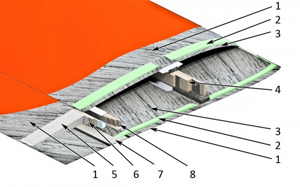 |
1 – Outer layers of our carbon spread tow laid at a ±45 (±30 Maxa Pro Windy) degree bias. Such layup results in high torsional stiffness in conjunction with the spar. Outer Spread Tow layers improve the wing durability and provide additional stiffness
2 – Herex core of the composite sandwich
3 – Inner layer of Kevlar on a ±45 degree bias (Spread tow on a ±30 degree bias on Maxa Pro Windy)
4 – 11.5mm (15mm on Maxa Pro Windy) wide spar caps of high strength IMS65 carbon fiber
5 – Rohacell flap core
6 – The front wall of the aileron is made of balsa plywood covered with glass fabric. This design reduces the weight of the control surface, while its height together with Spread Tow outer layers results in unsurpassed torsional stiffness
7 – Strip of the hinge material
8 – Rear wall of the wing from balsa plywood and fiberglass |
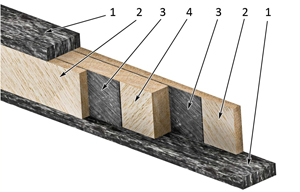 |
1 – Spar caps are hot cured from carbon pre-preg in an autoclave
2 – Outer balsa webbing at 45 degree bias
3 – Spread Tow carbon of ±45 degree layup totaling 0,04 mm in thickness
4 – Inner balsa webbing at 45 degree bias |
Model will be shipped in a returnable Sportube.
Available Wing Color Patterns:
| Pattern #1 |
Pattern #2 |
Pattern #3 |
Pattern #4 |
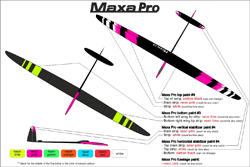 |
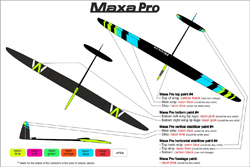 |
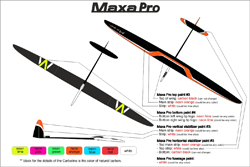 |
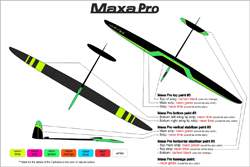 |
Specifications:
|
|
|
|
|
|
Maxa Pro Light HM F3J 3.5M
|
|
|
|
|
|
| Maxa Pro Windy HM F3J 3.5M |
138" |
68.1" |
1,144 sq. in. |
52 oz. |
8 m/s |
| Maxa Pro Hard 3.5M |
138" |
68.1" |
1,144 sq. in. |
55 oz. |
11 m/s |
| |
|
|
|
|
|
| Maxa Pro Light HM F3J 4M |
154" |
73.2" |
1,273 sq. in. |
49 oz. |
4 m/s |
| Maxa Pro Windy HM F3J |
154" |
73.2" |
1,273 sq. in. |
64 oz. |
8 m/s |
| Maxa Pro Hard 4M |
154" |
73.2" |
1,273 sq. in. |
65 oz. |
11 m/s |
| |
|
|
|
|
|
Maxa Pro EL Megalite 4M |
154" |
73.2" |
1,273 sq. in. |
33 oz. |
|
| Maxa Pro EL Ultralite 4M |
154" |
73.2" |
1,273 sq. in. |
41 oz. |
|
| Maxa Pro EL Lite 4M |
154" |
73.2" |
1,273 sq. in. |
50 oz. |
|
| Maxa Pro EL Windy 4M |
154" |
73.2" |
1,273 sq. in. |
58 oz. |
|
| * depending on version and installed equipment |
Availability, Pricing, Ordering:
|
Maxa Pro 3.5M (any)
Maxa Pro 4M (any)
Maxa Pro 3.5M EL (any)
Maxa Pro 4M EL (any)
|
Maxa Pro - Starting at $1,994
Maxa Pro Electric - Starting at $2,140
Color Configurator
|
|
|
Suggested Equipment

MKS 6130 Servos

Ballast

Wing Covers

Wing Bags
Tools

Color Configurator
Documents

Maxa Pro Building Instructions (coming)
Maxa Wing Settings Template
Maxa Aileron Settings
Maxa Flap Settings
Maxa Control Throws

Other

Maxa Pro Replacement Parts
Model Repair Kit
|